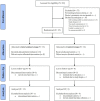"Not just another walking program": Everyday Activity Supports You (EASY) model-a randomized pilot study for a parallel randomized controlled trial
- PMID: 27175291
- PMCID: PMC4862805
- DOI: 10.1186/2055-5784-1-4
"Not just another walking program": Everyday Activity Supports You (EASY) model-a randomized pilot study for a parallel randomized controlled trial
Abstract
Background: Maintaining physical activity is an important goal with positive health benefits, yet many people spend most of their day sitting. Our Everyday Activity Supports You (EASY) model aims to encourage movement through daily activities and utilitarian walking. The primary objective of this phase was to test study feasibility (recruitment and retention rates) for the EASY model.
Methods: This 6-month study took place in Vancouver, Canada, from May to December 2013, with data analyses in February 2014. Participants were healthy, inactive, community-dwelling women aged 55-70 years. We recruited through advertisements in local community newspapers and randomized participants using a remote web service. The model included the following: group-based education and social support, individualized physical activity prescription (called Activity 4-1-1), and use of a Fitbit activity monitor. The control group received health-related information only. The main outcome measures were descriptions of study feasibility (recruitment and retention rates). We also collected information on activity patterns (ActiGraph GT3X+ accelerometers) and health-related outcomes such as body composition (height and weight using standard techniques), blood pressure (automatic blood pressure monitor), and psychosocial variables (questionnaires).
Results: We advertised in local community newspapers to recruit participants. Over 3 weeks, 82 participants telephoned; following screening, 68% (56/82) met the inclusion criteria and 45% (25/56) were randomized by remote web-based allocation. This included 13 participants in the intervention group and 12 participants in the control group (education). At 6 months, 12/13 (92%) intervention and 8/12 (67%) control participants completed the final assessment. Controlling for baseline values, the intervention group had an average of 2,080 [95% confidence intervals (CIs) 704, 4,918] more steps/day at 6 months compared with the control group. There was an average between group difference in weight loss of -4.3 [95% CI -6.22, -2.40] kg and reduction in diastolic blood pressure of -8.54 [95% CI -16.89, -0.198] mmHg, in favor of EASY.
Conclusions: The EASY pilot study was feasible to deliver; there was an increase in physical activity and reduction in weight and blood pressure for intervention participants at 6 months.
Trial registration: ClinicalTrials.gov identifier: NCT01842061.
Keywords: Motor activity; Retirement; Sedentary lifestyle; Self-management; Women.
Figures
References
-
- WHO . Global health risks: mortality and burden of disease attributable to selected major risks. Geneva: World Health Organization Press; 2009.
-
- Stein J. Stay moving, not still. Exercise slows aging and makes us feel better. Los Angeles: Los Angeles Times; 2009.
Associated data
Grants and funding
LinkOut - more resources
Full Text Sources
Other Literature Sources
Medical
Miscellaneous



